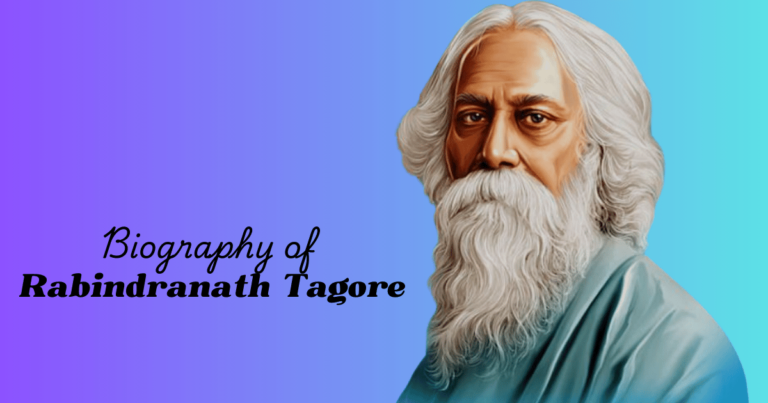Introduction
Rabindranath Tagore, often referred to as the “Bard of Bengal,” is a name that resonates across the world for his poetry, songs, and literary genius. Winner of the Nobel Prize in Literature, Tagore brought Indian art and philosophy to the global stage through his timeless works. His legacy is interwoven with his contributions as a poet, writer, playwright, philosopher, educator, and social reformer.
Whether you’re a history buff, literature enthusiast, or someone who admires great lives, Rabindranath Tagore biography will take you through the extraordinary life of Rabindranath Tagore. From his early years to the global recognition of his works, including “Gitanjali,” this post dives deep into his life story, achievements, and enduring impact on the world.
Table of Contents
Quick Facts About Rabindranath Tagore
| Category | Details |
|---|---|
| Date of Birth | May 7, 1861 |
| Place of Birth | Jorasanko Thakur Bari, Kolkata, India |
| Profession | Poet, Philosopher, Novelist, Playwright, Composer |
| Notable Works | Gitanjali, The Home and the World, Chitra |
| Awards | Nobel Prize in Literature (1913) |
| Death | August 7, 1941 |
Early Life and Family Background
Tagore was born into a prominent Bengali family in Kolkata, India, in 1861. His father, Debendranath Tagore, was a leading figure in the Brahmo Samaj, a reformist movement in Hinduism. Rabindranath’s upbringing was unconventional. Home-schooled, he was given a vast exposure to arts, history, literature, and philosophy while growing up in the culturally rich environment of Jorasanko Thakur Bari, the ancestral mansion of the Tagore family.
Education & Exposure to the West
Tagore’s educational background was as unique as his personality. Though he attended University College London briefly, he found traditional academic settings restrictive. This exposure to the West, however, played a significant role in shaping his worldview. It deeply influenced his mission to blend Eastern and Western philosophies, which became evident in his later works.
Literary Journey and Philosophy
The Birth of a Prodigy
Tagore published his first poems at the age of 16, under the pen name Bhanusimha. However, his true literary genius came to light in the subsequent years, with a collection of poems, essays, and novels written in Bengali.
“Gitanjali” Wins a Nobel Prize
One of Tagore’s most celebrated works, “Gitanjali” (an anthology of poems), earned him the Nobel Prize in Literature in 1913. He was the first non-European to receive this honor, cementing his place on the global literary stage. The collection is revered for its spiritual depth, universal themes, and unique poetic style.
Themes in Tagore’s Works
Tagore’s works often revolve around themes of humanism, spirituality, nature, and the interplay of tradition and modernity. His storytelling captured the struggles and aspirations of the Indian people while also addressing universal truths.
Some notable works include:
- “The Home and the World” (Ghare-Baire): A poignant novel depicting the emotional and political turmoil during India’s Swadeshi movement.
- “Kabuliwala”: A heartfelt short story exploring themes of friendship, separation, and humanity.
- “Chitra”: A play inspired by a story from the Mahabharata, celebrating feminist themes.
Contributions Beyond Literature
Education Reform
Tagore was a visionary educator who founded Visva-Bharati University in Santiniketan in 1921. His educational philosophy merged traditional Indian Gurukul values with Western pedagogic principles. Visva-Bharati became a hub of cultural and intellectual exchange.
Music and Art
Rabindranath Tagore composed over 2,000 songs, collectively called Rabindra Sangeet, which reflect a variety of emotions and themes. He also holds the unique distinction of authoring the national anthems of not one but two countries—India’s “Jana Gana Mana” and Bangladesh’s “Amar Shonar Bangla.”
Later in life, Tagore also ventured into painting, showcasing his versatility as a creative genius.
Political and Social Impact
Tagore was an advocate for Indian independence but had a nuanced approach to nationalism. His essay, “Nationalism,” critiqued the excesses of blind patriotism while advocating for universal humanism.
Tagore returned his knighthood, awarded by the British Crown, in protest of the Jallianwala Bagh massacre in 1919, making a powerful political statement.
FAQs About Rabindranath Tagore Biography
What makes Rabindranath Tagore’s poetry unique?
Rabindranath Tagore’s poetry is celebrated for its spiritual depth, lyrical beauty, and universal appeal. His works transcend cultural and geographical boundaries, often weaving themes of nature, love, human connection, and divinity.
Why is Tagore significant to Indian history?
Tagore was a multifaceted genius who played a pivotal role in India’s cultural revival during the British colonial period. Through his art, philosophy, and humanitarian efforts, he contributed significantly to the national consciousness.
Which languages did Tagore write in?
Tagore primarily wrote in Bengali but also translated many of his works into English to introduce his ideas to a global audience.
What are Rabindra Sangeet songs?
Rabindra Sangeet refers to the collection of over 2,000 songs composed by Tagore, encapsulating a variety of themes ranging from devotion and romance to patriotism.
What was Tagore’s philosophy on education?
Tagore believed education should foster creativity, curiosity, and a connection to nature. His institution, Visva-Bharati, embodied this ethos by encouraging holistic learning.
The Eternal Legacy of Rabindranath Tagore
Rabindranath Tagore biography was a testament to the power of creativity, intellect, and unwavering commitment to humanity. From his timeless poetry to his progressive outlook on education and society, Tagore continues to inspire generations worldwide.
For those looking to understand Indian literature and its soul, exploring Rabindranath Tagore’s works is an essential beginning. Pick up a copy of “Gitanjali” today or listen to his Rabindra Sangeet to experience the magic of his genius firsthand.

